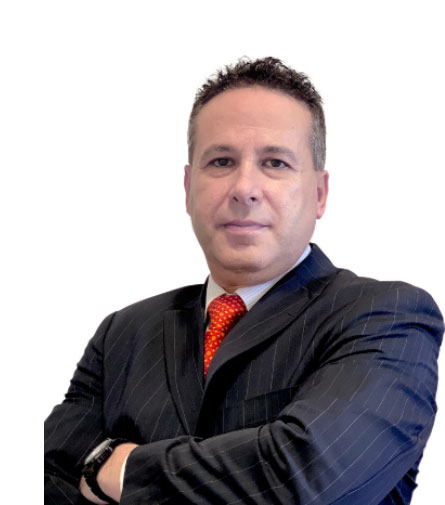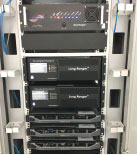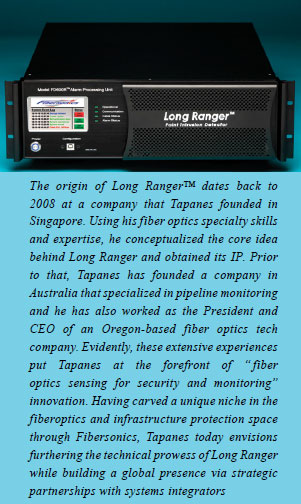 Edward Tapanes, Co-Founder, Co-CEO, and President
Edward Tapanes, Co-Founder, Co-CEO, and President Fiber optics technology has become synonymous with robust, high-speed connectivity today, as these glass-cored bundles of wires can transfer humongous volumes of data at lightning speeds across vast distances. Factors such as low post-installation maintenance, near-zero-power consumption for operation, low cost of deployment, and high signal quality retention have enabled the technology to be used in a number of applications where high-speed signal transfer is a necessity. However, a lesser recognized feature of fiber optic cables is their inherent sensitivity to physical impacts and subtle vibrations. This brings in the possibility of these cables being used as one-of-a-kind sensors, which in turn makes it an ideal tool for command and control operations.
Edward Tapanes, the co-founder, co-CEO, and President of Fibersonics, is a veteran who has in-depth knowledge about the practical applications of fiber optics technology in different fields. For over 30 years, Tapanes pioneered the development and installation of fiber optics technologies for critical infrastructure security and monitoring. Drawing on his rich industry experience and relentless R&D efforts toward distributed fiber optics sensing products and solutions, Fibersonics aims to redefine the approach to how companies monitor and secure critical infrastructures such as pipelines, airports, and remote power, oil and gas plants.
A NOVEL FIBER OPTIC DISTRIBUTED VIBRATION SENSOR (DVS)
Monitoring infrastructure spread across vast stretches of land has always been a cumbersome task for companies. Even well-scheduled human inspections that employ drones or helicopters is far from delivering a 24/7 security assurance. “Using conventional technologies to monitor such structures and premises is impractical as most sensors work at a single point. For example, if you need to monitor a very long pipeline or a large perimeter, you would require many hundreds or even thousands of sensors along those structures, and it becomes cost prohibitive and complex to manage,” mentions Tapanes. With its patented Long Ranger™ Distributed Vibration Sensor technology, Fibersonics is capable of repurposing any fiber optic cable into a sound and vibration sensor that can precisely detect movement, vibrations or sound anywhere along its length in real-time. As such, a fiber cable atop or beside a structure can sense any physical disturbance that might occur around it. Similar to the human body, the fiber optic cables mimic the nerves underneath the skin, while the Long Ranger system’s Alarm Processing Unit (APU) acts as the brain to gather and automatically analyze the information collected.
The APU is loaded with algorithms and signal processing capabilities to accurately interpret signals coming from a structure and precisely mark those detections as either a threat or normal ambient noise. “This capability is crucial, and it is what retains the users’ trust in the system.
Having a good system is half the job done because the detections should also be accurate and reliable. We have spent a considerable amount of time developing technologies that allow the system to be accurate, reliable, and automated so that the operator doesn’t have to go through the hassle of interpreting the detection; they simply need to respond to the message that the system sends out,” mentions Tapanes.
The unit effectively discriminates between patterns of interferences and environmental or traffic noises from potentially dangerous operational threats. By differentiating between nuisance and genuine concerns, the system can generate alarms that enable users to act with a higher degree of confidence or carry out automatic response mechanisms. For instance, by accurately detecting an anomaly at a certain point in the perimeter of an airport, security personnel can focus on the origin point via the surveillance cameras at the perimeter. Possibilities like these are limitless. Also, a single APU can process information from fiber optic cables that stretch more than 48 km. With an operating temperature of 0-50 degree Celsius, the APU does not require air-conditioned racks and its hardware platform consists of dedicated reprogrammable FPGA and DSP chips. Moreover, its firmware can be updated by TCP/IP. The 5.25” X16.5’” X22” unit weighs no more than 12 Kg and works on any 80-100 W outlet.
The fiber optic cable comes with seven different levels of “actual” physical sensitivity that makes it configurable for different structural and environmental conditions. The sensitivity along the length of the cable can be demarcated into any number of zones and configured individually via software. The relatively small diameter of the cable, enclosed in protective jackets, enables convenient installation.

In comparison to other conventional modes of infrastructure monitoring, the Long Ranger technology can operate over an unprecedented broad frequency range—from a mere 3Hz to 500 kHz—and it is touted as the world’s first and only distributed ultrasonic detector. The offering is perfect for detecting and locating early-stage leaks in pipelines much faster than other cable-based systems whose sensitivity and performance diminish with distance. “The cable is made entirely of glass and plastic. It does not require power to operate or suffer from corrosion or electromagnetic interferences,” says Tapanes. This results in near-zero field maintenance, long service life, relatively easy installation, and more importantly, cost-effectiveness.
A GO-TO-MARKET STRATEGY BASED ON SYNERGISTIC PARTNERSHIPS
Apart from the Long Ranger tech’s compelling value proposition, Fibersonics’ go-to-market strategy is another key differentiator for the company. “Having been associated with multiple companies in this market, I have seen business models that succeed and fail. When I started Fibersonics six years ago, I was looking for a more manageable yet rapidly expandable business model; one that aligns well with how critical infrastructure facilities availed services,” recalls Tapanes. He placed his bet on partnering with regional systems integrators across the globe, and the rest, as they say, is history.
The Long Ranger technology today secures all kinds of infrastructure—such as pipelines, border security, HV power lines, and perimeters of airports, solar farms, and refineries—across the U.S., Canada, Peru, Mexico, Switzerland, Belgium, Denmark, Turkey, Eastern Europe, China, South-East Asia and the Middle East.
While strategic partners are entrusted with the marketing, sales, and customer relationship aspects, Fibersonics’ core team takes care of the comprehensive training and quality assurance. Fibersonics also outsources the manufacturing of Long Ranger components, which enables them to focus deeper on final assembly, testing, and shipping. “We have a dedicated team of people to train our partners, who, at the end of the day, are like our customers. Beyond delivering intensive training, we work closely with them and pay keen attention to support. If any of our partners around the globe raise an issue, we typically respond within an hour. We can access all installed systems remotely and respond and fix problems very quickly,” affirms Tapanes.
"Fibersonics is capable of repurposing any fiber optic cable into a sound and vibration sensor that can precisely detect movement, vibrations and sound anywhere along its length in real-time"
In effect, the business model’s sleekness helps Fibersonics stay agile and unlock quick, scalable geographic expansions while being in the best interests of both sales integrators and critical infrastructure entities. It also allows Tapanes to involve actively in the R&D, production, installation, and support aspects of the business, wherein he gets to adequately exercise and impart his rich experience in the fiber optics market.
BUILT AND DRIVEN BY EXPERIENCE
Fibersonics is working to augment their signal detection algorithms with AI and deep learning capabilities to deliver better inferential detections and alarms. Every inch of the optical fiber cables collects vibration data that is analysis worthy (example: occurrence pattern recognition), which could ultimately help achieve a proactive security and monitoring stance. Besides, the more accurate the detections, the cables can scale to cover longer, bigger structures. Also, AI-enabled detections can increase the trust that operators have in the monitoring equipment.
In parallel to these developments, Fibersonics is also exploring methodologies to offer training solutions to its partners. “Because of our unique business model, and the fact that we focus hard on making our local sales partners experts in the technology, ‘technology-enabled’ modes of training are very important,” concludes Tapanes.

 Edward Tapanes, Co-Founder, Co-CEO, and President
Edward Tapanes, Co-Founder, Co-CEO, and President In comparison to other conventional modes of infrastructure monitoring, the Long Ranger technology can operate over an unprecedented broad frequency range—from a mere 3Hz to 500 kHz—and it is touted as the world’s first and only distributed ultrasonic detector. The offering is perfect for detecting and locating early-stage leaks in pipelines much faster than other cable-based systems whose sensitivity and performance diminish with distance. “The cable is made entirely of glass and plastic. It does not require power to operate or suffer from corrosion or electromagnetic interferences,” says Tapanes. This results in near-zero field maintenance, long service life, relatively easy installation, and more importantly, cost-effectiveness.
In comparison to other conventional modes of infrastructure monitoring, the Long Ranger technology can operate over an unprecedented broad frequency range—from a mere 3Hz to 500 kHz—and it is touted as the world’s first and only distributed ultrasonic detector. The offering is perfect for detecting and locating early-stage leaks in pipelines much faster than other cable-based systems whose sensitivity and performance diminish with distance. “The cable is made entirely of glass and plastic. It does not require power to operate or suffer from corrosion or electromagnetic interferences,” says Tapanes. This results in near-zero field maintenance, long service life, relatively easy installation, and more importantly, cost-effectiveness. 